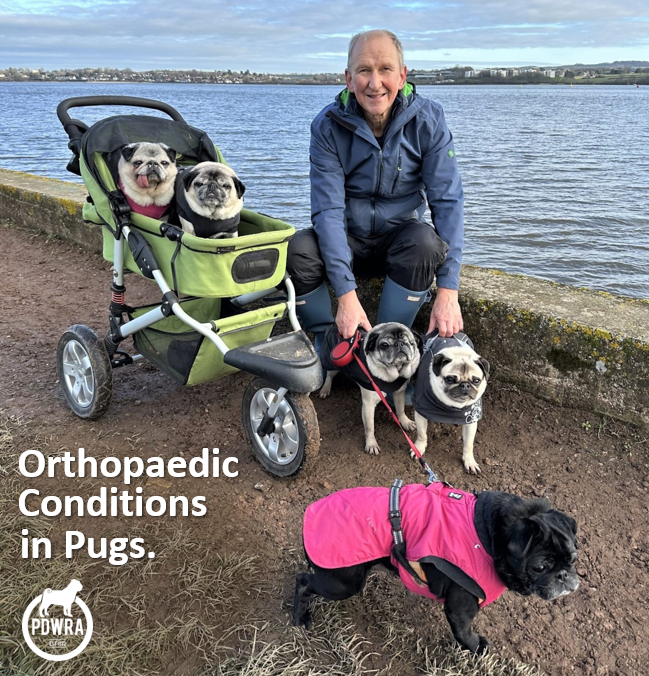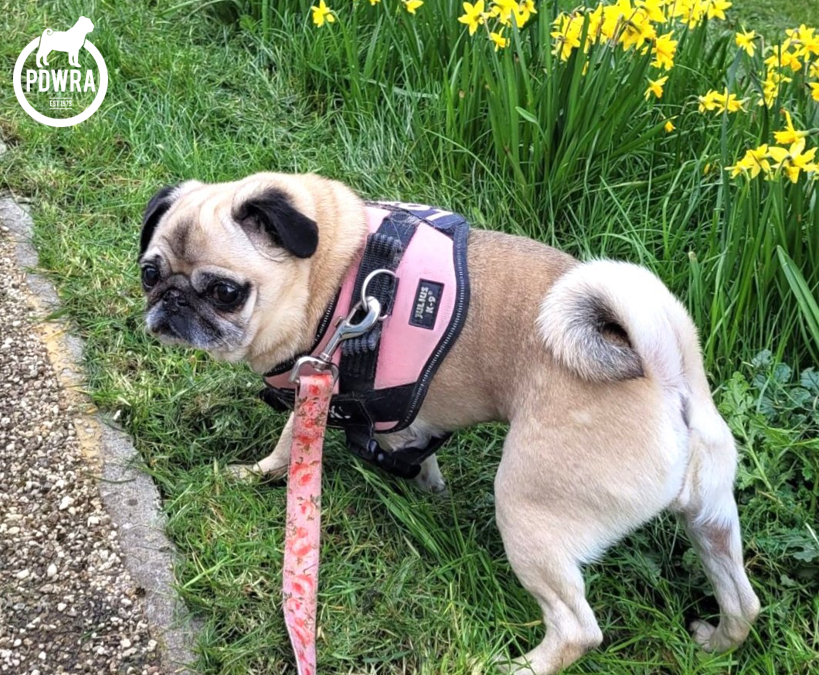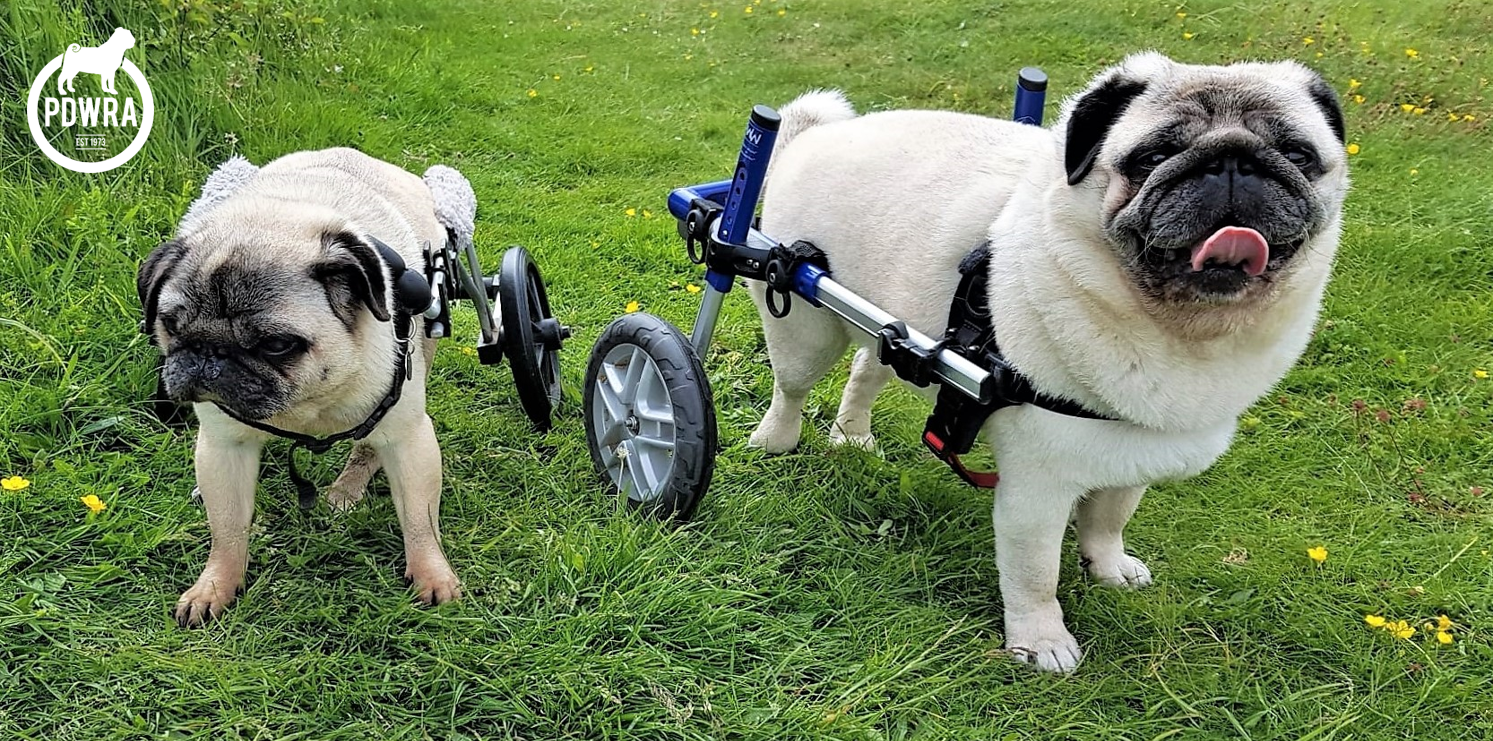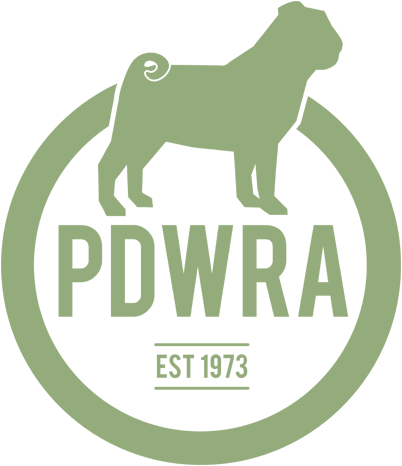
Orthopaedic Conditions in Pugs
Written by Malcolm McKee.
PDWRA Vet Advisor.
Pictured here with his grumble, before the loss of Lily (February ’23) and Missy (May ’23).
Most orthopaedic problems in pugs affect the hind limbs (back legs) rather than the fore limbs (front legs). Fortunately fractures (broken bones) and tumours (cancers) are very uncommon.
The two conditions that most commonly cause lameness and stiffness in pugs are hip dysplasia and medial patellar lunation.
Hip dysplasia
This is an inherited condition that causes the ball-and-socket hip joint to develop abnormally (excessive laxity) and leads to secondary osteoarthritis (also referred to as degenerative joint disease).
Lameness and/or stiffness involving one or both hind limbs may be evident and affected Pugs are often reluctant to exercise and have difficulty jumping. Common features on examination include muscle atrophy/wastage (especially the gluteal muscles around the hip) and pain when the hip joint is extended (limb pulled backwards).
Radiographs (X-rays) are necessary to confirm a diagnosis of hip dysplasia. Typical abnormalities include deformity of the femoral head (ball) and pelvic acetabulum (socket) and changes consistent with osteoarthritis (such as new abnormal bone formation – referred to as osteophytes).
Pugs that are lame/stiff will generally warrant medical treatment. Key aspects include: (1) weight control (2) exercise regulation and (3) analgesics (pain killer medications).
Dogs that are overweight should be placed on a diet, with calorie intake restricted, and their weight regularly monitored. The likes of a piece of cucumber should be given as a treat, rather than biscuits or table scraps.
Exercise should be regulated in a semi-controlled manner. Twisting, turning, jumping and climbing should be avoided. Small, frequent, regular walks, on the likes of a flexi-lead are preferable to long walks tearing around off the lead. Dogs will often have a threshold regarding the duration and type of exercise, beyond which lameness and stiffness will increase. It is important to recognise these limits and stay within them.

Non-steroidal anti-inflammatory drugs (NSAIDs) are the most common medication used in dogs with hip dysplasia and secondary osteoarthritis. If they are effective (less lame/stiff), the dose of drug should be reduced to the lowest possible to maintain the benefit, and if possible halted.
Paracetamol may also be considered in more severe cases, as well an the injectable Librela.
The majority of pugs can be managed satisfactorily with medical/conservative treatment. Those that aren’t may be candidates for surgery. Replacing the arthritic hip joint (referred to as a Total Hip Replacement, or THR), is preferable to cutting the head (ball) off the top of the femur (referred to as an Excisional Arthroplasty). Hip replacement surgery is a very specialised (and expensive) procedure – in experienced hands, it has a high success rate.
Medial patellar luxation
Also referred to as “slipping of the knee cap” (medial refers to the fact that the patella or knee cap dislocates onto the inside of the stifle/knee joint).
Affected pugs typically have a hopping gait/lameness, especially if the patella is slipping in and out of the groove in the femur (thigh bone), within the joint. A careful examination enables the abnormal movement of the patella to be detected. The severity of the condition is graded from 1 to 4, with 4 being the most severe.
The reason the patella luxates (dislocates or slips) out of the groove on the femoral bone is that the femur is deformed (referred to as femoral varus) and the hind limb bow-legged to some degree.
Radiographs (X-rays) are not necessary in order to diagnose medial patellar lunation – as mentioned previously this is based on a thorough examination. The main reason to obtain radiographs is to assess the degree of deformity of the femur bone, in dogs where surgical correction/“straightening” is being considered.
Many pugs with medial patellar lunation may be managed conservatively with weight control, exercise regulation, and if necessary NSAIDs (as low a dose as infrequently as possible). Dogs that fail to respond satisfactorily may be candidates for surgery.
Surgery aims to stabilise the patella within the femoral groove using one or more techniques. In dogs with mild deformity of the femur (and associated low-grade patella luxation), it is not necessary to correct the deformity (straighten the femur). In contrast, pugs with severe deformity of the femur (Grade 4/4 patella lunation), require the deformity to be corrected by cutting and straightening the bone (a bigger and more expensive operation).
All patellar luxation surgeries in dogs are intricate, especially in dogs as small as pugs, however, the success rate is good when performed by experienced surgeons. Following surgery it is important that exercise is severely restricted until bone and soft tissues have had a chance to heal.
Unfortunately hip dysplasia and patellar luxation are not uncommon in pugs. Both conditions are relatively easy to diagnose and the majority of dogs do not require an operation. The outlook in those pugs that have surgery is generally good, albeit the training and skill of the surgeon are important factors.
Malcolm McKee
BVMS MVS DSAO MACVSc MRCVS
Another very interesting article by Malcolm about spinal conditions common in pugs should be read, at:
https://pugwelfare-rescue.org.uk/spinal-conditions-in-pugs/


